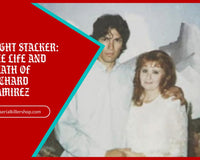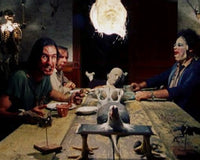
It’s hard to think of any film that has been more carefully examined and analyzed than Stanley Kubrick’s adaption of Stephen King’s novel The Shining. In fact, the 2012 documentary film Room 237 is entirely devoted to examining the various hidden meanings in the movie.
Some of the many theories about the references and symbolism that Kubrick supposedly inserted into The Shining have taken on true conspiracy theory status in the years since the film’s premiere in 1980. Here are some of the most intriguing.
Want more horror? Check out our limited edition horror merch collection!
The Native American Genocide

The theory that The Shining is about the Native American Genocide first took hold in an article called “The Family of Man” by Bill Blakemore. Blakemore outlines the importance that Kubrick places on the multiple appearances of large tins of Calumet baking powder with the Indian chief image in the Overlook Hotel’s kitchen.
“Calumet” means “peace pipe.” He also notes the dominant presence of Indian décor, artwork, and artifacts throughout the hotel, but no actual Native American characters.
The Fake Apollo Moon Landing

This very popular conspiracy theory suggests that Kubrick himself participated in faking the Apollo 11 moon landing in 1969. Many believers think The Shining was Kubrick’s way of dealing with his involvement in this secret project.
Many images are cited to support this theory: Danny’s Apollo 11 sweater, room 237 representing the moon’s distance from the earth (237,000 miles), lots of Tang cans in the pantry, and the patterns in the carpet matching those on the Apollo launch pad.
Jack Torrance is the Devil

Many fans of the movie argue that the unique positioning of Jack’s body in the black and white photo from 1921 at the very end of the film is Kubrick saying that Jack is actually the Devil himself. Tarot cards and other historic occult imagery traditionally show Satan (called Baphomet) in this same position.
Jack’s very presence back in 1921 also supports this belief. Fans also note that Stephen King refers to a black and white image of Jesus in the book, and Kubrick’s reference to the Devil is just one of many instances in which he reverses King’s imagery (such as with the colors of red and yellow).
The Jewish Holocaust

Theories that The Shining is about the Holocaust are as prevalent as those about the Native American Genocide. Believers point to Kubrick’s repeated use of the number 42—the year of Hitler’s “Final Solution.”
Others also point to Jack’s vintage German typewriter, and the fact that Jack types “All work and no play makes Jack a dull boy” over and over, symbolic of the Nazi obsession with mechanization and order. There’s also a lot of eagle imagery in the film (the eagle was the symbol of the Third Reich), and the English translation of Jack’s “Adler” typewriter just happens to be “eagle.”
The Myth of the Minotaur

In Greek mythology, the Minotaur (a creature with a bull’s head and a man’s body) lives in a maze-like labyrinth and is killed by the hero Theseus. Some fans of The Shining contend that Kubrick is retelling the myth with Jack as the Minotaur, Danny as Theseus, and the hotel itself as the labyrinth.
What’s the evidence? The hedge maze where Jack chases Danny (and eventually meets his end), the maze-like pattern on the carpet where Danny plays with toy cars, Jack’s “bull-like” demeanor as he descends into madness, and the infamous Minotaur-like skiing poster which can be seen behind the twins (Danny retraces his steps through the carpet maze to escape).
Make sure to check out our All Work No Play Dull Boy Shirt!













1 comment
Anna
So far fetched. Silly.